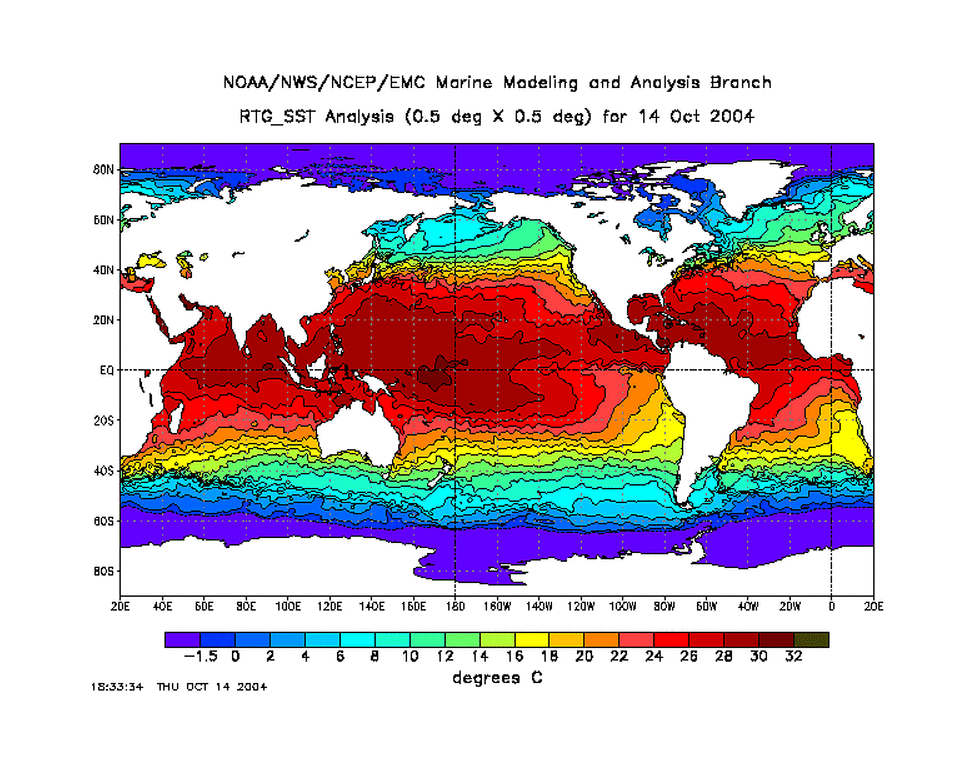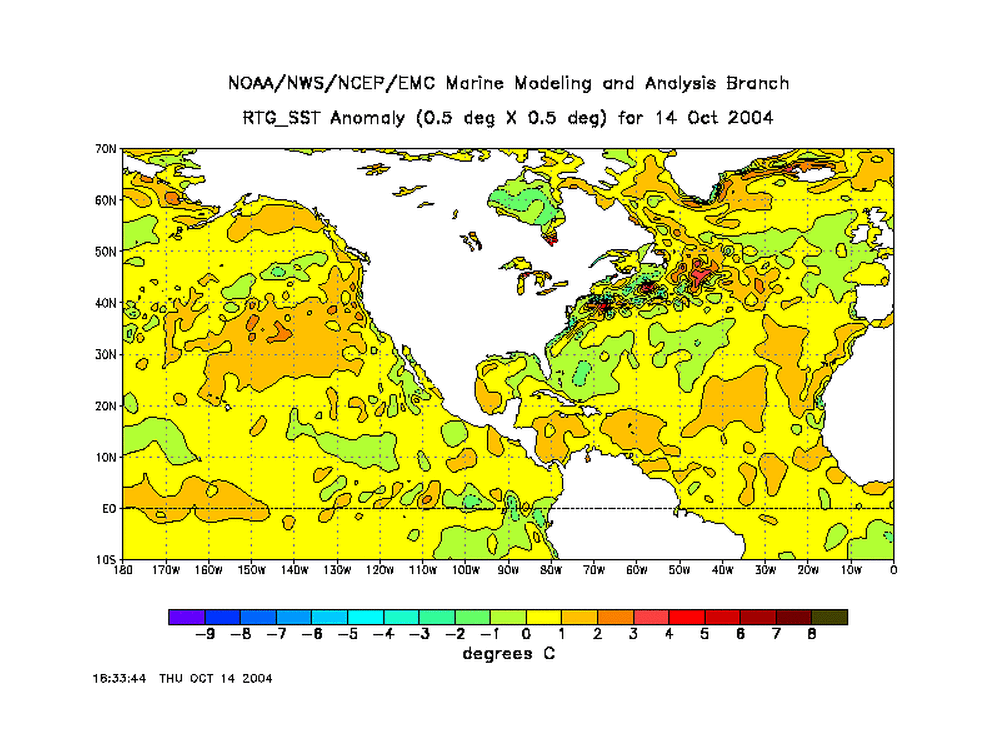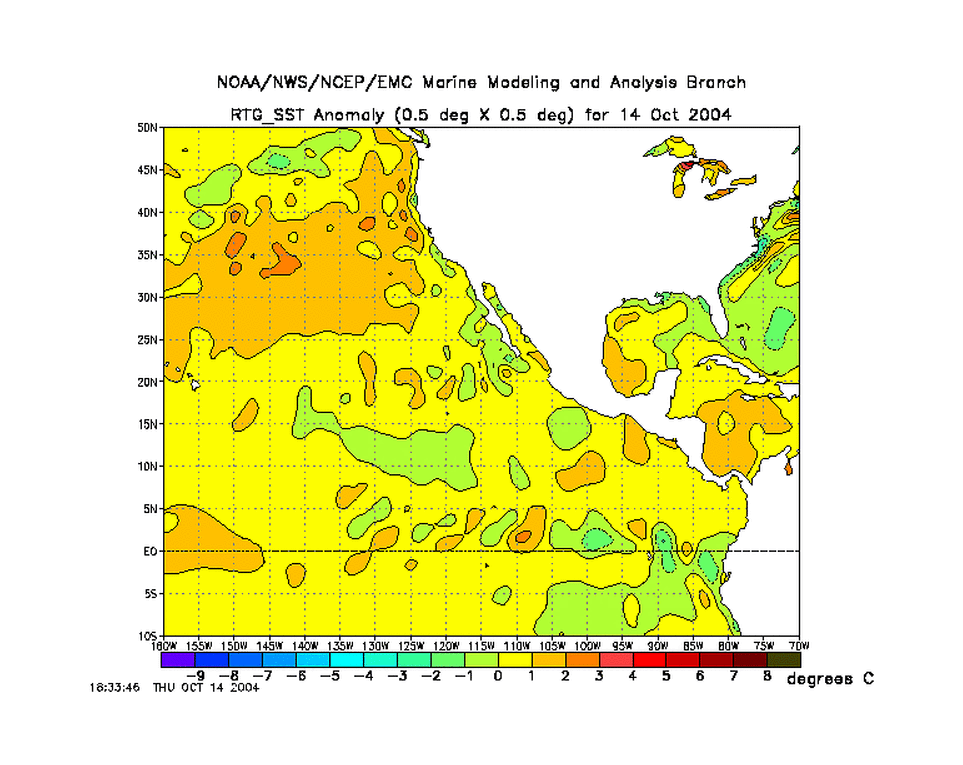![[NCEP Logo]](/peth04/20041014235107im_/http://polar.ncep.noaa.gov/mmab/images/ncep80.gif)
Real-time, global, sea surface temperature (RTG_SST) analysis
N American region SST Analysis
GLOBAL SST:
N. AMERICAN REGION SST:

N. ATLANTIC SST:
N.E. PACIFIC SST:
Important: Anyone accessing this page using the URL "polar.wwb.noaa.gov" should change immediately to "polar.ncep.noaa.gov", as the former URL is being retired on August 23, 2004.
NOTE for frequent visitors: Go to http://polar.ncep.noaa.gov/sst/Changed_RTG_SST.html for information on changes in the operational run-time and the data-ingest window.
A daily, high-resolution, real-time, global, sea surface temperature (RTG_SST) analysis has been developed at the National Centers for Environmental Prediction/Marine Modeling and Analysis Branch (NCEP / MMAB). The analysis was implemented in the NCEP production suite 30 January 2001, and provides the daily ocean surface temperatures for the Meso-Eta model.
The daily sea surface temperature product is produced on a half-degree (latitude, longitude) grid, with a two-dimensional variational interpolation analysis of the most recent 24-hours buoy and ship data, satellite-retrieved SST data, and SST's derived from satellite-observed sea-ice coverage. The algorithm employs the following data-handling and analysis techniques:
Satellite retrieved SST values are averaged within 0.5 deg. grid boxes with day and night 'superobs' created separately for each satellite;
Bias calculation and removal, for satellite retrieved SST, is the technique employed in the 7-day Reynolds-Smith climatological analysis;
SST reports from individual ships and buoys are separately averaged within grid boxes;
The first-guess is the prior (un-smoothed) analysis with one-day's climate adjustment added;
Late-arriving data which did not make it into the previous SST analysis are accepted if they are less than 36 hours old;
Surface temperature is calculated for water where the ice cover exceeds 50%, using salinity climatology in Millero's formula for the freezing point of salt water:t(S) = -0.0575 S + 0.0017 S3/2 - 0.0002 S2,with S in psu.
An inhomogeneous correlation-scale-parameter l, for the correlation function: exp(-d2/l2) , is calculated from a climatological temperature gradient, asl = min ( 450 , max( 2.25 / |grad T| , 100 )),with d and l in kilometers. "grad T" is in deg. C / km
Evaluations of the analysis products have shown it to produce realistically tight gradients in the Gulf Stream regions of the Atlantic and the Kuroshio region of the Pacific, and to be in close agreement with SST reports from moored buoys in both oceans. Also, it has been shown to properly depict the wintertime colder shelf water -- a feature critical in getting an accurate model prediction for coastal winter storms.
The evaluation of the RTG_SST analysis is available by clicking the link to the RTG_SST Verification page.
Grib files for the global SST product are available at the following FTP sites:
ftp://ftpprd.ncep.noaa.gov/pub/data/nccf/com/fnl/prod (most recent 2 days)Inspect subdirectories of the form "sst.YYYYMMDD",ftp://polar.ncep.noaa.gov/pub/sst (most recent 7 days)
where "YYYYMMDD" represents an 8-character date string, e.g., "20020717".
This replaces the use of the FTP server ftp.ncep.noaa.gov, which is no longer available.
ftp://polar.ncep.noaa.gov/pub/history/sst (fields back to Feb. 11, 2001)
For information on reading and unpacking GRIB files, go to
http://polar.ncep.noaa.gov/faqs/Tools.html
The RTG_SST analysis is done over all ocean areas and the Great Lakes. There is no analysis over land. The land values are filled by a Cressman interpolation to produce a complete grid for possible interpolation to other grids. The ocean and land areas are defined by a land sea mask. This data set is an ASCII file, ls.dat, which may be found at the FTP site:
ftp://polar.ncep.noaa.gov/pub/history/sst/lsmask
The spatial grid is defined identically to the grid for the SST arrays, with indices starting just east of the Greenwich Meridian and near the South Pole. The values in ls.dat are set to 0 over the ocean and 3 over land. It can be read by the following Fortran code:
DIMENSION LS(720,360)C
OPEN (11,FILE='ls.dat')
C Read in land sea tags (0 for ocean; 3 for land)
CREAD (11,'(80I1)') LS
STOP
END
For additional information about data-management and analysis techniques, contact William.Gemmill@noaa.gov.
For information about the run cycle and digital data format, contact Bert.Katz@noaa.gov.






